The Acer Swift 3 SF314 Notebook Review: Swift Gets Swifter With Ryzen 4000
by Brett Howse & Andrei Frumusanu on May 5, 2020 8:00 AM ESTDisplay Analysis
Acer offers just a single display option on the 14-inch AMD based Swift 3, which is a 1920x1080 IPS display. Considering the price, this is the right option, although it is interesting that they are offering a 13.5-inch 3:2 Intel based Swift 3 in the SF313-52. The 3:2 works quite well for productivity, although less-so for gaming where 16:9 generally suffers from fewer issues.
There is no touch capability with this display, which is a bit of a shame, but also understandable with the other features offered. Acer did well to hit their target price range, and they made overall good decisions on where to invest. Touch is a nice to have, but not a necessity, although when you are used to having it, it is amazing how often you try to touch the screen.
To see how the display stacks up, the laptop was tested with Portrait Display’s CalMAN software suite. For brightness and contrast, the X-Rite i1Display Pro colorimeter was used, and for color accuracy readings the X-Rite i1Pro 2 spectrophotometer was employed.
Brightness and Contrast
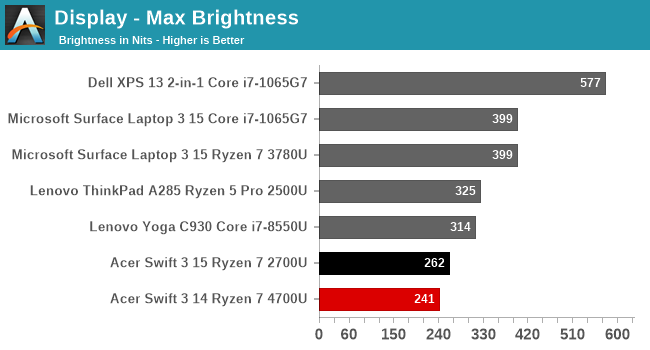
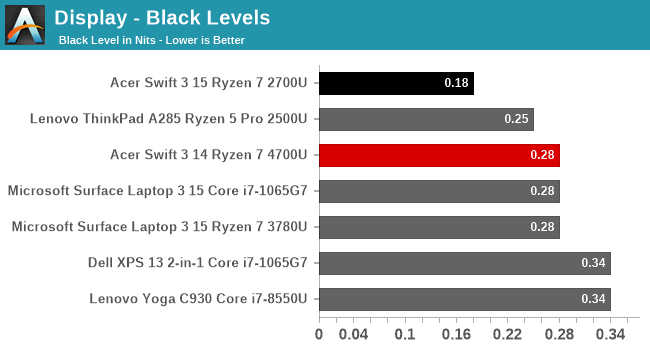
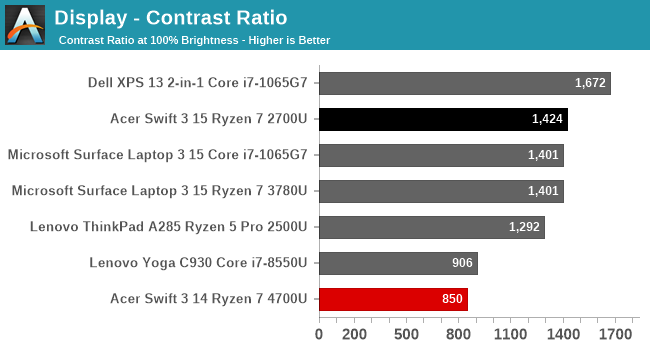
The Acer Swift 3 does not get off to a great start. In a budget notebook, displays tend to be one of the first things on the chopping block. Luckily, we’ve moved past the era where these types of notebooks would offer 1366x768 TN panels, but Acer’s 1920x1080 IPS choice doesn’t offer very good black levels, and their backlight is somewhat weak. It is an inauspicious start.
Grayscale

Grayscale measures the laptops ability to display white levels, from 0% (black) to 100% (white), and the Swift 3 performs quite poorly here. The blue levels are far too strong across most of the range. Gamma is also way off of the expected 2.2 level.
Gamut
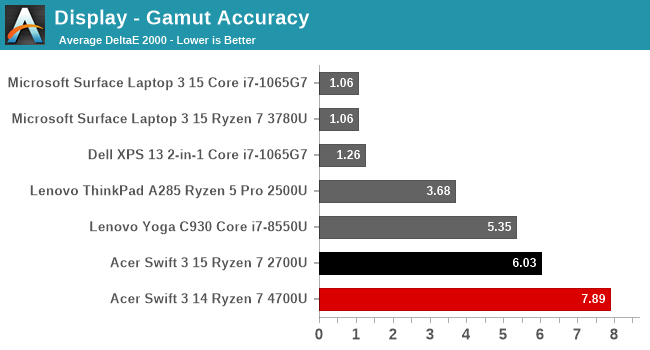
Windows 10 is still an sRGB system first and foremost, so proper sRGB gamut support is required for proper color accuracy. The Acer Swift 3 unfortunately does not cover anywhere near the sRGB gamut, which means that the LED backlighting was likely another area where some money was saved. Although grayscale can be salvaged with some ICC profiles, without full sRGB backlighting this laptop would likely suffer further if an ICC was applied because it simply cannot cover the entire sRGB spectrum.
Saturation
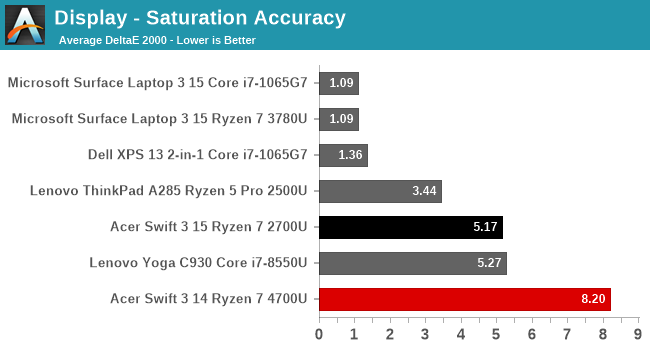
The saturation test covers the primary and secondary colors, but unlike the gamut where they are just measured at 100% level, we test them on 4-bit steps from 0% to 100%. Since we’ve already determined the laptop can’t hit the full sRGB gamut, it is no surprise to see the saturation sweeps suffer.
Gretag Macbeth
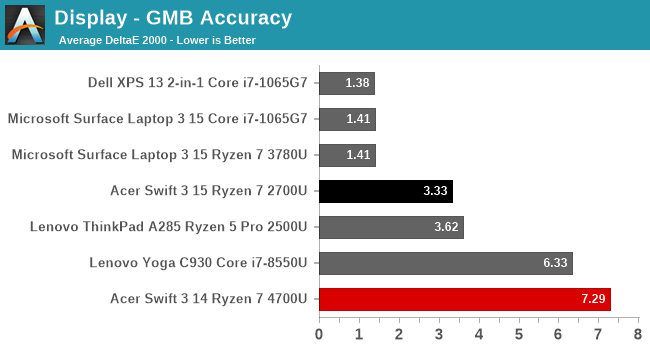
The Gretag Macbeth tests colors off of the primary and secondary axis, including the important skin tones, but with a display that can’t reproduce the entire sRGB range, the Acer Swift 3 naturally performs quite poorly on this test.
Colorchecker
Finally, we have the colorchecker, where you can more easily visualize the color errors with this display. This is a relative test, since any errors in your own display will influence the result, but on the bottom of the swatches is the color requested, and the top shows the color produced by the display. It is not pretty.
Display Conclusion
Overall, despite the poor showing here, the display is in-line with expectations at this price point. Over the last couple of years, there has been a push for better displays, and laptop makers have made the jump to 1920x1080 IPS panels pretty much across the board; so even though this display is poor compared to better IPS-based laptops, it still does offer the good viewing angles an IPS panel enjoys, and 1920x1080 works very well on a 14-inch screen size.
The very poor backlighting really does hamper the capabilities of this notebook. If you wanted to use it for editing photos or video, the internal components like the CPU, memory, and GPU, really would help, but the included display with its lack of sRGB coverage would certainly hinder the work. For basic office tasks, or even gaming, most people who are looking at a laptop at this price point will likely not be too concerned about the display, but just be aware that this one is deficient in several areas.


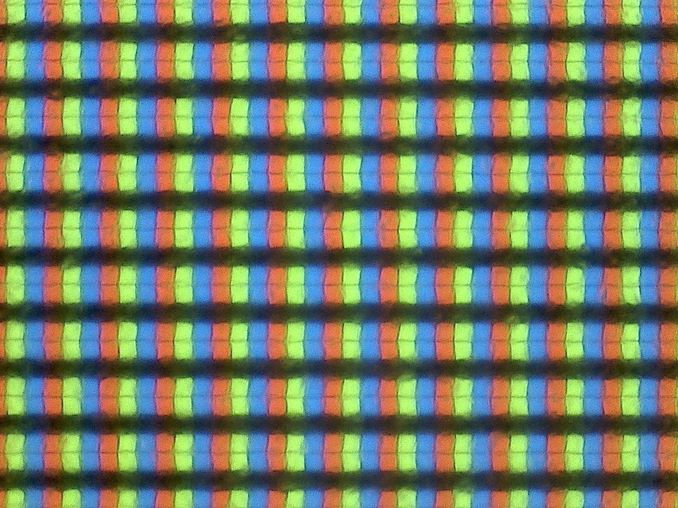













191 Comments
View All Comments
Oxford Guy - Thursday, May 7, 2020 - link
8 watts is not awesome:"The laptop really struggled with its thermals, dropping the framerate into single digits often. The device attempted to run at around 18 Watts of power draw, slightly over the 15 Watt TDP, but in fact only averaged around 8 Watts during this run."
Not being able to cover the pathetic old sRGB color space with even a slight level of accuracy is not awesome.
sonny73n - Thursday, May 7, 2020 - link
It’s the heat issue on heavy load. Looking at HSF with the back cover opened on TH, I was thinking how to modify it for a better heat dissipation. There’s only one heatpipe running about 3 inches to the fins. I doubt repaste will help much.uzzi38 - Tuesday, May 5, 2020 - link
Because battery life is also about the rest of the components in the laptop as well. The screen especially so. Those results are normalised battery size, not normallised with rest-of-system power draw in mind.Jorgp2 - Tuesday, May 5, 2020 - link
Isn't that still up to AMD?Intel helped spec out low power displays to use with Athena devices
They also make their own chipsets.
SolarBear28 - Tuesday, May 5, 2020 - link
I don't think AMD has the bargaining power (or marketing clout) to force OEM's to use expensive, lower power components the same way Intel does. But they have done something similar by requiring certain specs with their HS series processors.Spunjji - Wednesday, May 6, 2020 - link
Not, it's up to the OEM.OEM's don't even *have* to use Athena, though it looks like they're being heavily "persuaded".
yeeeeman - Tuesday, May 5, 2020 - link
D'oh, obviously. That is where the 650$ price is. In cheap components.SolarBear28 - Tuesday, May 5, 2020 - link
Exactly. The XPS 13 2 in 1 is one of the most efficient Intel devices out there due to its screen and other components. The Swift 3 beats the Yoga C930 in the normalized test, so AMD is roughly in the same ballpark as Intel on power consumption. But its up to the OEM's to do the rest. With their HS series processors AMD pushed certain requirements on ASUS and the ROG G14 provides great battery life. Also the leaked specs of some Renoir Thinkpads point to a proper lower power display being an option, I'm looking forward to seeing reviews of the T14s.Spunjji - Wednesday, May 6, 2020 - link
This. It's not entirely a fair fight.neogodless - Tuesday, May 5, 2020 - link
If I understand correctly, we're talking about battery life from an 8-core processor being only 25% off that of a 4-core processor. That's actually pretty good.